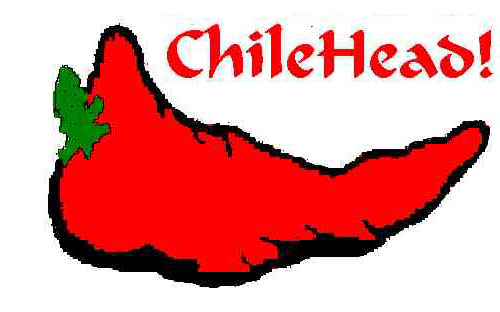 Chester Chile's
Chester Chile's 
 Chester Chile's
Chester Chile's 
Things about Peppers (HOT mostly!)
Settting Aside those Peppers

Caution!
Botulism: (Clostridium botulinum) Frequently Asked Questions
Growth of the bacterium Clostridium botulinum in canned food may cause botulism--a deadly form of food poisoning. These bacteria exist either as spores or as vegetative cells. The spores, which are comparable to plant seeds, can survive harmlessly in soil and water for many years.
When ideal conditions exist for growth, the spores produce vegetative cells which multiply rapidly and may produce a deadly toxin within 3 to 4 days of growth in an environment consisting of:
a moist, low-acid food
a temperature between 40°F and 120°F
less than 2 percent oxygen
Botulinum spores are on most fresh food surfaces. Because they grow only in the absence of air, they are harmless on fresh foods.
Most bacteria, yeasts, and molds are difficult to remove from food surfaces. Washing fresh food reduces their numbers only slightly. Peeling root crops, underground stem crops, and tomatoes reduces their numbers greatly. Blanching also helps, but the vital controls are the method of canning and making sure the recommended research-based process times, found in these guides, are used. The processing times in these guides ensure destruction of the largest expected number of heat-resistant microorganisms in home-canned foods. Properly sterilized canned food will be free of spoilage if lids seal and jars are stored below 95°F. Storing jars at 50°F to 70°F enhances retention of quality.
Food Acidity and Processing Methods
Whether food should be processed in a pressure canner or boiling-water canner to control botulinum bacteria depends on the acidity in the food. Acidity may be natural, as in most fruits, or added, as in pickled food. Low-acid canned foods contain too little acidity to prevent the growth of these bacteria. Acid foods contain enough acidity to block their growth, or destroy them more rapidly when heated.
Botulism is a potentially fatal food poisoning characterized by blurred or double vision, speech and breathing difficulty and progressive paralysis. Without prompt and correct treatment, one-third of those diagnosed may die. Clostridium botulinum bacteria are widespread in the environment and may be found on various produce, including peppers and garlic, but their spores are harmless when there is oxygen in the environment. However, the spores can produce a deadly toxin when in an anaerobic (oxygen free), low acid environment. Recent FDA studies have shown that garlic in an oil mixture can support bacterial growth and toxin production even when very few Clostridium botulinum spores are present.
To paraphrase Dirty Harry, "This is the deadliest microbial toxin known to humans. You've got to ask yourself one question: Do I feel lucky? Well, do ya ChileHead?"
For futher info about canning, goto: http://www.foodsafety.gov/ or Center for Food Safety & Applied Nutrition http://vm.cfsan.fda.gov/
Salmonellosis is an infection with a bacteria called Salmonella. Most persons infected with Salmonella develop diarrhea, fever, and abdominal cramps 12 to 72 hours after infection. The illness usually lasts 4 to 7 days, and most persons recover without treatment. However, in some persons the diarrhea may be so severe that the patient needs to be hospitalized. In these patients, the Salmonella infection may spread from the intestines to the blood stream, and then to other body sites and can cause death unless the person is treated promptly with antibiotics. The elderly, infants, and those with impaired immune systems are more likely to have a severe illness.
For futher info about Salmonella, goto: http://www.cdc.gov/ncidod/diseases/foodborn/salmon.htm
Hints for storing pepper product!!
Jim Campbell of www.wildpepper.com says:
I prevent killing off "clients" (and kill off bacteria) by several ways:
1. I don't use materials that might contain bad things
2. My pH is always less than 3.5
3. I maintain good hygeine
4. I hot fill at 185 F
-Jim C
Mike Stallcup of the {CH] list writes:
Drying chiles before placing them in your sauces will also allow you to get rid of those microbes.
"Once you thoroughly dry the chiles you can put them in oil without danger of botulism, yeasts, etc. because the moisture needed by these bugs to grow is not available." - Mike S
Folks, Lister Donald R Jordan advised against microwaving hot chiles as you can have an invisible cloud of pure cap vapor in the kitchen. I can attest this is not a pleasant thing. I've told the story before but it bears repeating.
One February evening I noticed my supply of ground hab powder was nearly gone. I have plenty of dried habs, but needed to dry them more in order to grind them. I figured the microwave was perfect. Next thing I know all the windows and doors are open, we have resurrected all the electric fans from winter storage, and my wife is standing in the front yard asking (none too politely) what is it that I have done now?
Do NOT try this in your home.
Brandon C. Nuttall
bnuttall@kih.net
CHILI (sic) PEPPER for Lasting Lessons by Susan Munguia
They have good food in Texas, I can tell you this is true. I've had my share of chicken-fried steak and down home barbecue. So when a cowboy looked at me with a twinkle in his eye, and said "I've got a lil' somethin' here I think that you should try." I was ready to be a Texan, to be part of the Lone Star State.
Then he took a chili pepper [1] and tossed it on my plate. I didn't know they taste like fire, so I popped it in my mouth. One arm went east and the other west, my legs went north and south. It was hotter than a branding iron, hotter than the Texas sun [2]. I leaped from my chair, did flips in the air. It was not what you'd call fun.
The wranglers [3] started laughing as the sweat rolled down my cheeks. My mouth and tongue and lips burned for the next 500 weeks [4]! So if you try a chili pepper, please take my advice -- Have a water pitcher handy that is filled with lots of ice!! --------
[1] Insert your favorite chile pepper here :-)
[2] Baloney, nothings hotter than the Texas sun.
[3] or the Chile Heads
[4] Insert obligatory ring of fire reference here
Bon Appetit!
From ChileHeads List -Sent by:Bill Woodward (Bill_CCHKK@yahoo.com)